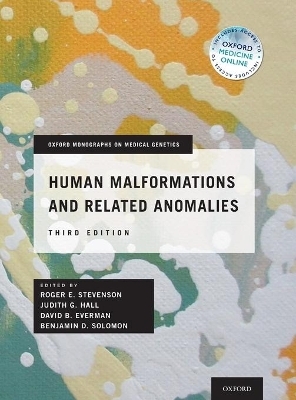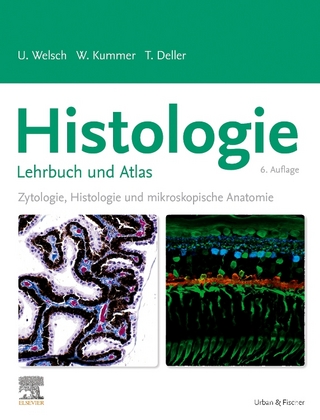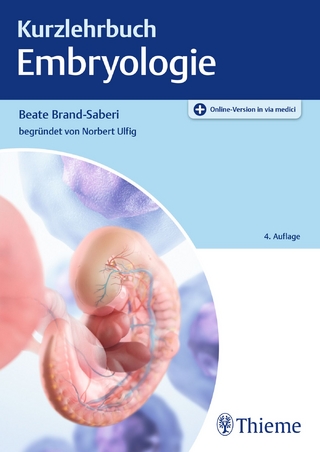
Human Malformations and Related Anomalies
Oxford University Press Inc (Verlag)
978-0-19-938603-1 (ISBN)
Roger E. Stevenson, MD, is Senior Clinical Geneticist at Greenwood Genetic Center in Greenwood, South Carolina. Judith G. Hall, MD, is Professor Emerita of Pediatrics and Medical Genetics at the University of British Columbia based at Children's & Women's Health Centre of British Columbia in Vancouver. David B. Everman, MD, is an Associate Clinical Geneticist at Greenwood Genetic Center in Greenville, South Carolina. Benjamin D. Solomon, MD, is Chief of the Division of Medical Genomics at the Inova Translational Medicine Institute and Associate Professor of Pediatrics at the Virginia Commonwealth University School of Medicine.
Introduction ; Roger E. Stevenson and Judith G. Hall ; Chapter 1 Limbs ; Roger E. Stevenson ; Introduction ; 1.1 Limb Deficiency ; 1.1a Absence of Limb ; 1.1b Absent Radius ; 1.1c Absent Ulna ; 1.1d Absent Humerus ; 1.1e Absence and Hypoplasia of the Tibia ; 1.1f Absent Fibula ; 1.1g Absence and Hypoplasia of the Femur ; 1.1h Terminal Transverse Limb Deficiency ; 1.2 Synostosis ; 1.2a Carpal and Tarsal Coalition ; 1.2b Metacarpophalangeal and Metatarsophalangeal Synostosis ; 1.2c Proximal Symphalangism ; 1.2d Distal Symphalangism ; 1.2e Humeroradial Synostosis ; 1.2f Radioulnar Synostosis ; 1.2g Tibiofibular Synostosis ; 1.2h Sirenomelia ; 1.3 Constriction Rings ; 1.4 Duplications, Excessive Partitions, and Accessory Bones ; 1.5 Bowing of Long Bones ; 1.6 Short Stature ; 1.7 Tall Stature ; 1.8 Limb Overgrowth ; 1.9 Increased Bone Density ; 1.10 Decreased Bone Density ; 1.11 Osteolysis ; 1.12 Anomalies of the Patella ; 1.13 Arthrogryposis ; 1.13a Amyoplasia ; 1.13b Distal arthrogryposis ; 1.13c Fetal akinesia phenotype ; 1.13d Pterygium syndromes ; Chapter 2 Hands/Feet ; David B. Everman ; Introduction ; Polydactyly ; 2.1a Preaxial Polydactyly ; 2.1b Postaxial Polydactyly ; 2.1c Mesoaxial Polydactyly ; Syndactyly ; 2.2a Syndactyly Type I ; 2.2b Syndactyly Type II ; 2.2c Syndactyly Type III ; 2.2d Syndactyly Type IV ; 2.2e Syndactyly Type V ; 2.2f Cenani-Lenz Syndactyly ; 2.2g Symbrachydactyly ; Brachydactyly ; 2.3a Brachydactyly Type A1 ; 2.3b Brachydactyly Type A2 ; 2.3c Brachydactyly Type A3 ; 2.3d Brachydactyly Type B ; 2.3e Brachydactyly Type C ; 2.3f Brachydactyly Type D ; 2.3g Brachydactyly Type E ; Deficiency ; 2.4a Preaxial Deficiency ; 2.4b Postaxial Deficiency ; 2.5 Terminal Transverse Deficiency ; 2.6 Split-Hand-Foot Malformation ; 2.7 Macrodactyly ; 2.8 Camptodactyly ; 2.9 Clubfoot ; Chapter 3 Pectoral and Pelvic Girdles ; Louanne Hudgins and Neda Zadeh ; Introduction ; 3.1 Clavicular Hypoplasia/Aplasia ; 3.2 Clavicular Pseudoarthrosis ; 3.3 Altered Shape and Other Abnormalities of the Clavicle ; 3.4 Sprengel Anomaly ; 3.5 Glenoid Hypoplasia ; 3.6 Anomalies of the Pelvic Bone ; 3.7 Developmental Dysplasia of the Hip ; 3.8 Coxa Vara ; 3.8 Coxa Valga ; Chapter 4 Spine and Ribs ; Louanne Hudgins and Neda Zadeh ; Introduction ; 4.1 Occipitalization of the Atlas ; 4.2 Aplasia/Hypoplasia of the Odontoid Process of the Axis ; 4.3 Klippel-Feil Anomaly ; 4.4 Segmentation Defects of the Vertebrae ; 4.5 Altered Vertebral Body Contour ; 4.6 Coronal Clefts of the Vertebrae ; 4.7 Coronal Clefts of the Vertebrae ; 4.8 Spondylolysis and Spondylolisthesis ; 4.9 Sacral Agenesis ; 4.10 Anomalies of the Ribs ; 4.11 Cervical Rib ; 4.12 Pectus Excavatum ; 4.13 Pectus Carinatum ; 4.14 Anomalies of the Sternum ; Chapter 5 Skull ; John M. Graham, Jr. and Pedro Sanchez-Lara ; Introduction ; 5.1 Craniosynostosis ; 5.2 Kleeblattschadel ; 5.3 Wide Cranial Sutures ; 5.4 Anomalies of Fontanelles ; 5.5 Parietal Foramina ; 5.6 Wormian Bones ; 5.7 Cranial Dermal Sinus ; 5.8 Scalp Vertex Aplasia ; 5.9 Thin Cranial Bones ; 5.10 Undermineralization of the Skull ; 5.11 Craniotabes ; 5.12 Thick Cranial Bones ; 5.13 Sclerosis and Hyperostosis of the Skull ; 5.14 Vertex Birth Molding ; 5.15 Breech Head and Bathrocephaly ; 5.16 Other Cranial Deformations ; 5.17 Anomalies of the Sella Turcica ; 5.18 Anomalies of the Foramen Magnum ; 5.19 Anomalies of Other Basal Foramina ; 5.20 Basilar Impression ; 5.21 Cephalohematoma ; 5.22 Miscellaneous Anomalies of the Skull ; Chapter 6 Facial Bones ; Karen Gripp ; Introduction ; 6.1 Metopic Synostosis ; 6.2 Orbital and Ocular Hypotelorism ; 6.3 Orbital and Ocular Hypertelorism ; 6.4 Zygomatic Hypoplasia ; 6.5 Absent Manidble ; 6.6 Congenital Asymmetry of Facial Skeleton ; 6.7 Micrognathia ; 6.8 Midface Retrusion and Hypoplasia ; 6.9 Midline Facial Clefting ; Chapter 7 Skin, Hair and Nails ; Mary Beth Dinulos ; Introduction ; 7.1 Aplasia Cutis Congenita ; 7.2 Ichthyosis ; 7.3 Ectodermal Dysplasias ; 7.4 Epidermolysis Bullosa ; 7.5 Cutaneous Hamartomas ; 7.6 Vascular Malformations ; 7.7 Pigmentation Abnormalities ; 7.8 Mosaicism ; 7.9 Epidermal Appendage Abnormalities ; 7.10 Disorders of Connective Tissue ; Chapter 8 Muscle ; Judith G. Hall ; Introduction ; 8.1a Hypertrophia Musculorum Vera ; 8.1b Kocher-Debre Semaalagne ; 8.1c Hyperekplexia ; 8.2 Generalized Decrease in Muscle Mass ; 8.3 Facial Muscle Deficiency ; 8.3a Deficiency of Extraocular Eye Muscles ; 8.3b Asymmetric Crying Face ; 8.3c Mobius Syndrome ; 8.3d Absence and Underdevelopment of the Tongue ; 8.3e Macroglossia ; 8.4 Diagraphagmatic Defect ; 8.5 Achalasia ; 8.6a Prune Belly Syndrome ; 8.6b Other Abdominal Wall ; 8.7a Poland Anomaly ; 8.7b Lower Limb Poland Anomaly ; 8.8 Other Muscle Hypoplasia ; 8.9a Muscle Variants ; 8.9b Muscle Variant Abnormalities Associated with Chromosomal Disorders ; 8.9c Accessory Muscles ; 8.9d Atavisms ; Chapter 9 Brain ; Alasdair G. W. Hunter ; Introduction ; 9.1 Microcephaly ; 9.2 Megalencephaly ; 9.3 Aprosencephaly-Atelencephaly ; 9.4 Holoprosencephaly ; 9.5 Malformations of Cortical Development ; 9.5a Lissencephaly ; 9.5b Pachygyria ; 9.5c polymicrogyria ; 9.5d Heterotopia ; 9.5e Focal Cortical Dysplasia ; 9.6 Agenesis of the Corpus Callosum ; 9.7 Cavum ; 9.8 Hydrocephalus ; 9.9 Colpocephaly ; 9.10 Hydranencephaly ; 9.11 Porencephaly ; 9.12 Cerebellar Abnormalities ; 9.13 Cystic Malformations ; 9.14 Chiari Malformations ; Chapter 10 Spinal Cord ; David Dyment ; Introduction ; 10.1 Primary Tethered Cord ; 10.2 Split Cord ; 10.3 Tailgut Cyst ; 10.4 Syringomelia ; 10.5 Myelocystocele ; 10.6 Meningocele ; 10.7 Neurenteric Malformation ; 10.8 Intraspinal Cysts ; Chapter 11 Brain and Spinal Cord ; Roger E. Stevenson ; Introduction ; 11.1 Anencephaly ; 11.2 Iniencephaly ; 11.3 Encephalocele ; 11.4 Spina Bifida ; Chapter 12 The Eye ; Elias I. Traboulsi, Shomoukh AlShamekh and Natario L. Couser ; Introduction ; 12.1 Anophthalmia ; 12.2 Microphthalmia and Typical Uveal Coloboma ; 12.3 Cyclopia and Synophthalmia ; 12.4 Cryptophthalmos ; 12.5 Blepharophimosis ; 12.6 Other Anomalies of the Eyelids ; 12.7 Corneal Malformations ; 12.8 Aniridia ; 12.9 Anterior Segment Dysgenesis ; 12.10 Peters Anomaly ; 12.11 Cataracts ; 12.12 persistent Hyperplastic Primary Vitreous ; 12.13 Optic Nerve Hypoplasia ; 12.14 Optic Pit ; 12.15 Morning Glory Disc Anomaly ; Chapter 13 External Ear ; Dorothy Katherine Grange ; Introduction ; 13.1 Absence of the External Ear ; 13.2 Small Ear ; 13.3 Large Ear ; 13.4 Cryptotia ; 13.5 Synotia and Otocephaly ; 13.6 Polyotia ; 13.7 Anomalies of the External Auditory Canal ; 13.8 Abnormal Ear Position ; 13.9 Lop-Cup Ear Anomaly ; 13.10 Protruding Ear ; 13.11 Variants of the Helix and Anthelix ; 13.12 Variants of the Ear Lobe ; 13.13 Auricular Tags ; 13.14 Auricular Pits ; 13.15 Ear Lobe Creases and Pits ; 13.16 Deformation of the Auricle ; Chapter 14 Middle Ear ; John D. Carey and Albert H. Park ; Introduction ; 14.1 Absence, Hypoplasia, and Malformations of the Malleus ; 14.2 Fusion Defects of the Malleus ; 14.3 Absence, Hypoplasia and Malformation of the Incus ; 14.4 Fusion Defects of the Incus ; 14.5 Absence, Hypoplasia and Malformation of the Stapes ; 14.6 Congenital Fixation of the Stapes ; 14.7 Absence of the Oval Window ; 14.8 Congenital Cholesteatoma ; 14.9 Persistence of the Stapedial Artery ; 14.10 Highly Placed Jugular Bulb ; Chapter 15 Inner Ear ; Eloise J. Prijoles ; Introduction ; 15.1 Inner Ear ; 15.2 Prelingual Hearing Loss ; Chapter 16 Nose ; Margaret P. Adam ; Introduction ; 16.1 Absent Nose ; 16.2 unilateral Arhinia ; 16.3 Small Nose ; 16.4 Cleft Ala Nasi ; 16.5 Bifid Nose ; 16.6 Choanal Atresia ; 16.7 Supernumerary Nares ; 16.8 Proboscis ; 16.9 Minor Anomalies of the Nose ; 16.10 Nasal Tooth ; 16.11 Deviation of the Nasal Septum ; 16.12 Turbinate Deformity ; 16.13 Arhinencephaly ; 16.14 Encephalocele Involving the Nose ; Chapter 17 Lips ; Marilyn Jones ; Introduction ; 17.1 Median Cleft Lip ; 17.2 Cleft Lip with or without Cleft Palate ; 17.3 Cleft Palate ; Chapter 18 Tongue ; Michael I. Cunningham ; Introduction ; 18.1 Absence and Underdevelopment of the Tongue ; 18.2 Macroglossia ; 18.3 Absence of Lingual Frenulum ; 18.4 Ankyloglossia ; 18.5 Glossopalatine Ankylosis ; 18.6 Supernumerary Tongue ; 18.7 Bifid Tongue ; 18.8 Fissured Tongue, Scrotal Tongue, Lingua Plicata ; 18.9 Median Rhomboid Glossitis ; 18.10 Pigmented Fungiform Papillae of the Tongue ; 18.11 Choristoma of the Tongue ; 18.12 Lymphangioma of the Tongue ; 18.13 Hemangioma of the Tongue ; 18.14 Mixed Hamartoma of the Tongue ; 18.15 Teratoma of the Tongue ; 18.16 Lingual Thyroid ; Chapter 19 Teeth ; Hitesh Kapadia ; Introduction ; 19.1 Absence of One or More Teeth ; 19.2 Macrodontia ; 19.3 Microdontia ; 19.4 Supernumerary Teeth ; 19.5 Abnormalities of Tooth Shape ; 19.6 Enamel Dysplasia ; 19.7 Dentin Dysplasia ; 19.8 Abnormalities of Tooth Eruption ; 19.9 Dental Malocclusion ; Chapter 20 Heart ; Paul Stephen Kruszka and Laura Olivieri ; Introduction ; 20.1 Atrial Septal Defect ; 20.2 Atrioventricular Septal Defect ; 20.3 Ventricular Septal Defect ; 20.4 Left Ventricular Outflow Obstruction ; 20.5 Right Outflow Tract Obstruction ; 20.6 Conotruncal Defects ; 20.7 Double Outlet Right Ventricle ; 20.8 Single Ventricle ; 20.9 Ebstein ; 20.10 Tricuspid Atresia ; 20.11 Pulmonary Venous Anomalies ; 20.12 Coronary Anomalies ; 20.13 Heterotaxy ; Chapter 21 Systemic Vasculature ; Lynne M. Bird ; Introduction ; 21.1 Interrupted Aortic Arch ; 21.2 Right Aortic Arch ; 21.3 Cervical Aortic Arch ; 21.4 Double Aortic Arch ; 21.5 Double Lumen Aortic Arch ; 21.6 Innominate Artery Variants ; 21.7 Subclavian Artery Variants ; 21.8 Patent Ductus Arteriosus ; 21.9 Coarctation of the Aorta ; 21.10 Peripheral Pulmonic Stenosis ; 21.11 Persistent Left Superior Vena Cava ; 21.12 Inferior Vena Cava Variants ; 21.13 Congenital Absence of Portal Vein ; 21.14 Congenital left Renal Vein Anomalies ; 21.15 patent Ductus Venosus ; 21.16 Scimitar Syndrome ; 21.17 Deep Vein Abnormalities ; Chapter 22 Lymphatic System ; Stavit Allon Shalev ; Introduction ; 22.1 Lymphedema ; 22.2 Intestinal Lymphangiectasia ; 22.3 Cystic Renal Lymphangiectasia ; 22.4 Generalized Lymphatic Dysplasia ; 22.5 Pulmonary Lymphangiectasia ; 22.6 Fetal Cystic Hygroma ; 22.7 Lymphangioma ; 22.8 Lymphangioleiomyomatosis ; Chapter 23 Spleen ; Arthur S. Aylsworth ; Introduction ; 23.1 Asplenia,Congenital,Nonsyndromal ; 23.2 Asplenia, Congenital, Syndromal ; 23.3 Polysplenia ; 23.4 Positional Alterations of the Spleen ; 23.5 Splenic Fusion ; 23.6 Accessory Spleen ; 23.7 Splenic Structural Variation ; 23.8 laterality: Situs Inversus ; 23.9 Laterality: Situs Ambiguus ; Chapter 24 Lower Respiratory Organs ; Caleb P. Bupp and Roger E. Stevenson ; Introduction ; 24.1 Bifid Epiglottis ; 24.2 Laryngeal Atresia, Webs, and Stenosis ; 24.3 Laryngeal Cleft ; 24.4 Absent Trachea ; 24.5 Tracheal Stenosis ; 24.6 Congenital Tracheal Cartilaginous Sleeve ; 24.7 Tracheoesophageal Fistula ; 24.8 Pulmonary Agenesis ; 24.9 Primary Pulmonary Hypoplasia ; 24.10 Congenital Cystic Adematoid Malformation ; 24.11 Congenital Lobar Emphysema ; 24.12 Diaphragmatic Hernia ; Chapter 25 Ventral Wall of the Trunk ; Cynthia J. Curry and Jacob Hogue ; Introduction ; 25.1 Sternal Defects ; 25.2 Ectopia Cordis ; 25.3 Gastroschisis ; 25.4 Umbilical Hernia ; 25.5 Omphalocele ; 25.6 Limb-Body Wall Defect ; 25.7 Exstrophy of the Bladder ; 25.8 Exstrophy of the Cloaca ; Chapter 26 Upper Gastrointestinal System ; H. Eugene Hoyme and Roger E. Stevenson ; Introduction ; 26.1 Pharyngeal Fistula ; 26.2 Congenital Pharangeal Diverticula ; 26.3 Esophageal Atresia and Tracheoesophageal Fistula ; 26.4 Esophageal Webs and Rings ; 26.5 Tubular Esophageal Duplications ; 26.6 Enterogenous Cysts ; 26.7 Esophageal Diverticula ; 26.8 Heterotopic Gastric Mucosa ; 26.9 Congenital Short Esophagus ; 26.10 Achalasia ; 26.11 Chalasia ; 26.12 Atresia and Stenosis of the Stomach ; 26.13 Microgastria ; 26.14 Diverticula of the Stomach ; 26.15 Duplication of the Stomach ; 26.16 Defects of Gastric Musculature ; 26.17 Malposition of the Stomach ; 26.18 Mucosal Heterotopia ; 26.19a Pyloric Atresia ; 25.19b Infantile Hypertrophic Pyloric Stenosis ; 26.20 Duodenal Atresia and Stenosis ; 26.21 Duodenal Duplications ; 26.22 Duodenal Diverticula ; 26.23 Malrotation of the Duodenum ; 26.24 Congenital Aganglionic Duodenum ; 26.25 Extrinsic Vascular Obstruction of the Duodenum ; 26.26 Congenital Paraduodenal Hernia ; Chapter 27 Small and Large Intestines ; Roger E. Stevenson ; Introduction ; 27.1 Jejunal Atresia and Stenosis ; 27.2 Ilial Atresia andr Stenosis ; 27.3 Colon Atresia andr Stenosis ; 27.4 Multiple Intestinal Atresias ; 27.5 Megacolon ; 27.6 Malrotation of Intestines ; 27.7 Duplications and Cysts of Intestine ; 27.8 Meckel Diverticulum ; Chapter 28 Rectum/Anus ; Cathy A. Stevens ; Introduction ; 28.1 Atresia of the Rectum and Anus ; 29.2 Rectal Duplication ; Chapter 29 Liver, Gall Bladder, and Pancreas ; Ian D. Krantz and Kosuke Izumi ; Introduction ; 29.1 Anomalies of Liver Shape and Lobation ; 29.2 Liver Dysplasia ; 29.3 Intrahepatic Biliary Duct Atresia ; 29.4 Agenesis of the Gallbladder ; 29.5 Extrahepatic Biliary Atresia ; 29.6 Cysts of Biliary Systems ; 29.7 Structural Variation of the Gallbladder ; 29.8 Absence of the Pancreas ; 29.9 Structural Variation of the Pancreas ; 29.10 Pancreas Cysts and Dysplasias ; 29.11 Pancreas Ectopia and Heterotopia ; Chapter 30 The Urinary Tract ; Jane Alison Evans ; Introduction ; 30.1 Renal Agenesis ; 30.2 Renal Hypoplasia ; 30.3 Autosomal Recessive Polycystic Kidney Disease ; 30.4 Autosomal Dominant Polycystic Kidney Disease ; 30.5 Renal Dysplasia ; 30.6 Familial Nephronophthisis/Medullary Cystic Disease ; 30.7 Medullary Sponge Kidney ; 30.8 Obstructive Renal Cystic Disease ; 30.9 Supernumerary Kidney ; 30.10 Horseshoe Kidneys ; 30.11 Renal Ectopia ; 30.12 Duplication of the Ureter ; 30.13 Absent Urinary Bladder ; 30.14 Congenital Megacystis ; 30.15 Bladder Diverticulum ; 30.16 Urachal Anomalies ; 30.17 Urethral Agenesis/Atresia ; 30.18 Posterior Urethral Valves and Urethral Stenosis ; 30.19 Urethral Duplication ; Chapter 31 Male Genital System ; Roger E. Stevenson ; Introduction ; 31.1 Absent Penis ; 31.2 Micropenis ; 31.3 Hypospadias ; 31.4 Epispadias ; 31.5 Hidden or Concealed Penis ; 31.6 Megalourethra ; 31.7 Diphallia ; 31.8 penoscrotal Transposition ; 31.9 Ectopia-Accessory Scrotum ; 31.10 Cryptorchidism ; 31.11 Absent or Small Testis ; 31.12 Polyorchidism ; 31.13 Ectopic Testis ; 31.14 Undermasculinization ; 31.15 Wolffian Duct Malformation ; 31.16 Persistent Mullerian Ducts ; 31.17 Splenogonadal Fusion ; 31.18 Inguinal hernia ; 31.19 Hydroceles ; Chapter 32 Female Genital System ; Leah W. Burke ; Introduction ; 32.1 Ovarian Dysgenesis ; 32.2 Mixed Gonadal Dysgenesis ; 32.3 Ovotesticular Disorder of Sexual Development ; 32.4 Ambiguous Genitalia ; 32.5 Mullerian Aplasia ; 32.6 Absence of Fallopian Tubes ; 32.7 Incomplete Mullerian Fusion ; 32.8 Cervical Aplasia ; 32.9 Vaginal Aplasia ; 32.10 Transverse Vaginal Septum ; 32.11 Longitudinal Vaginal Septum ; Chapter 33 Breasts ; Roger E. Stevenson ; Introduction ; 33.1 Amastia-Hypomastia ; 33.2 Enlarged Breasts ; 33.3 Supernumerary Nipples ; 33.4 Widely Spaced Nipples ; 33.5 Gynecomastia ; Chapter 34 Asymmetric Growth and Generalized Overgrowth ; Jennifer M. Kalish ; Introduction ; 34.1 Hemihypoplasia ; 34.2 Hemihyperplasia/Hemihypertrophy ; 34.3 Generalized Overgrowth ; Chapter 35 Twins ; Judith G. Hall ; Introduction ; 35.1 Dizygotic Twinning ; 35.2 Vanishing Twin ; 35.3 Fetus Papyraceus ; 35.4 Monozygotic Twins ; 35.5 Mirror Image Twins ; 35.6 Twin to Twin Transfusion ; 35.7 Acardia ; 35.8 Conjoined Twins ; 35.9 Parasitic Twins ; 35.10 Sacral Teratoma ; Chapter 36 Umbilical Cord and Placenta ; Isabel Filges ; Introduction ; 36.1 Molar Transformation of the Placenta ; 36.2 Placental Mesenchymal Dysplasia ; 36.3 Chorangioma ; 36.4 Placentation in Twinning ; 36.5 Umbilical Cord Loops ; 36.6 Umbilical Cord Knots ; 36.7 Umbilical Cord length ; 36.8 Umbilical Cord Insertion ; 36.9 Vascular Anomalies of the Umbilical Cord ; 36.10 Umbilical Cord Cyst ; 36.11 Umbilical Cord Hernia ; 36.12 Umbilical Cord Torsion ; 36.13 Umbilical Cord helical Ulceration ; 36.14 Anomalies of Umbilical Cord Separation ; 36.15 Umbilical Cord Diameter ; 36.16 Umbilical Cord Disruption ; Appendix ; Subject Index
| Erscheint lt. Verlag | 10.12.2015 |
|---|---|
| Reihe/Serie | Oxford Monographs on Medical Genetics |
| Verlagsort | New York |
| Sprache | englisch |
| Maße | 287 x 221 mm |
| Gewicht | 2395 g |
| Themenwelt | Medizin / Pharmazie ► Medizinische Fachgebiete |
| Studium ► 1. Studienabschnitt (Vorklinik) ► Histologie / Embryologie | |
| Studium ► 2. Studienabschnitt (Klinik) ► Humangenetik | |
| ISBN-10 | 0-19-938603-X / 019938603X |
| ISBN-13 | 978-0-19-938603-1 / 9780199386031 |
| Zustand | Neuware |
| Informationen gemäß Produktsicherheitsverordnung (GPSR) | |
| Haben Sie eine Frage zum Produkt? |
aus dem Bereich


